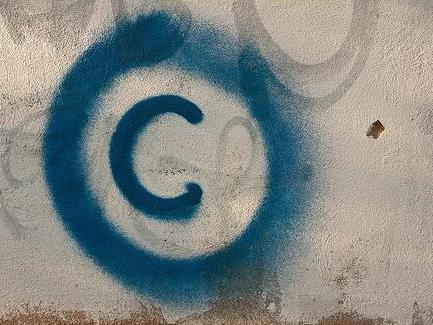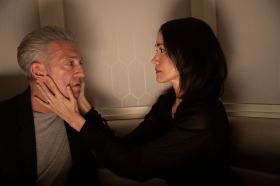‘The words of the prophets are written on the subway walls’ – Simon & Garfunkel Image by Horia Varlan, Informed,
As Australia moves towards controversial copyright changes, the formal representatives of the Australian screen and publishing sector remains bitterly opposed to fair use, that US approach to copyright which both the Productivity Commission and the Law Reform Commission argue we should use here.
Read: Productivity Commission lays out final report to much dismay
Read: Creatives will lose default copyright under government recommendations
Screen Producers Australia, for instance, has just published its response to the Productivity Commission’s Report into Intellectual Property Arrangements, and remains gobsmacked by its ideas.
The language is apocalyptic.
‘Put simply, if the Commission’s recommendations on copyright were implemented, the Australian film and television sector would go from an internationally renowned industry producing films like Lion and Hacksaw Ridge and television programs like The Kettering Incident and Glitch, to a cottage industry overnight.’
Publishers are similarly angry.
Read: Good for lawyers, bad for creatives
We really do have a big fat mess in front of us on this. The Productivity Commission is known to favour free market economics, which is bound to flummox an industry based on market intervention for cultural reasons. It also covers a huge range of topics in a vast array of industries, based on territories, the notion of a license and a reflexively hostile dependence on private property.
American expert buys in
Just as this brew is foaming out of the bucket, Professor Patricia Aufderheide of the School of Communication, American University in Washington D.C. has arrived at Queensland University of Technology as part of her Fullbright Scholarship. She is a proponent of fair use. Last night she was joined by filmmaker and musician Andrew Garton and Dr Rebecca Giblin from Monash University at an informal ACMI-X event to talk about Fair Use: Myth v Reality for Creators.
She has physically been here for nine days, but she has spent months last year reading all the extensive submission to the various reports commissioned by government about intellectual property, which must have been a daunting exercise in repetition as the parties shouted past each other. She is an internationalist, who is tracking the legislative evolution of IP around the world.
Her professional methodology is based on the idea that the social process of the law in action only makes sense if you research the lived experience of the participants. At the moment she is scrabbling to find the touch points by which her deep knowledge can be useful to local filmmakers.
Ultimately a historian, she is also a film critic, with a strong attachment to documentary. Over a decade ago, she and her colleague Professor Peter Jaszi provided the academic consultation on a collective document called Documentary Filmmakers Statement of Best Practice in Fair Use, available in full from the Center for Media and Social Impact. The authoring organisations are deep in documentary practice, including the Association of Independent Video and Filmmakers, the International Documentary Association and Women in Film and Video.
Since then, she has been a lead investigator for the Code of Best Practice in Fair Use for the Visual Arts. There is also a Code of Best Practice for Academic and Research Libraries.
Those flabby lines conceal the extent to which she is a leader and activist, responsible for interrogating, inciting and organising the various communities of communicators around a common problem – that creators in the US don’t understand and use the magic provisions of fair use, which tip the balance of power away from the lawyers defending the owners.
She is coming to the Australian International Documentary Conference, is on two panels, and is asking filmmakers to fill in a survey about their experience of IP, which we also mentioned last week. It is painless and interesting and provides an opportunity to hammer out some quick comments.
What’s different about fair use
Fair use, according to the US Government Copyright Office, ‘ is a legal doctrine that promotes freedom of expression by permitting the unlicensed use of copyright-protected works in certain circumstances… such as criticism, comment, news reporting, teaching, scholarship, and research..’
We use fair dealing, which works with a specified set of exceptions by which IP can be used without permission. They are research or study; criticism or review; parody or satire; reporting news and professional advice by a legal professional.
They look pretty similar except that the US provisions are based on the function while the fair dealing is a specified list. The fair use advocates claim that a limited list cannot take account of the pace of change in digital communications. They argue that obvious functions like collecting URLs by Google are not protected. While our law lumbers around, standard practice is technically illegal. There are lots of other examples like government documents which should be free to circulate.
Why would the Australian sector argue against a flexible system? Some people claim that we would have to build a pile of case law to create precedent, which is likely to be a menace. Others would say the weight of international agreement is actually against fair use.
But I think there are two fundamental reasons. One is that we have a system of payment for usage which has many faces, managed by the collection societies, which enable our creators to be paid for domestic and overseas use, and also extract revenue from the educational sector. There is a lot of money in that, which we are entitled to receive.
The other is that the issue of fair use becomes entangled immediately in those larger questions around territorial licenses, defending geoblocking, making ISPs accountable and attacking piracy. All of which the sector is defensive about because they are so hard to explain to the public and our political leaders.
Warnings from the US experience
According to Patricia Aufderheide, the Documentary Filmmakers Statement of Best Practice in Fair Use arose because creators were severely inhibited by the steel ring of private property around existing footage, sounds, music and written statements. It was a period of chaos, as user-generated material poured onto Youtube, and sites like Vimeo were beginning to host high quality shorts. Netizens can treat the law with contempt until the studios declare war, but professional filmmakers are bound by contracts, must sign indemnities and buy insurance, and sell material to timid broadcasters.
It was a classic deadening effect. Filmmakers stayed away from archival footage and avoided using snatches of music. Meanwhile, there were horrible examples like Warner’s harvesting of money for Happy Birthday, Google’s digitisation grab for books, and the way that studios accepted stock in Youtube to ignore the IP problems.
What were small indy filmmakers to do? The code showed them how to take advantage of fair use, because they knew they could defend their cases. The concepts are not hard – as Aufderheide said, it boils down to transformation and scale. Add a new creative use to material and only take what you need. In the ten years since the code came out, nobody has been sued.
Filmmaker Andrew Garton provided an Australian example to the ACMI audience, which touches on the confusion around our approach and the underlying nastiness of corporate practice. A council supports a community choir, in which some members are living with disabilities, to sing one concert a year at Christmas time. The administration knows it must secure and pay for performing rights though it had to be reminded that the underlying texts for music and songs are protected by a separate layer of rights as well.
All this is well understood, policed by the collections societies who have made it simple, and they refer to complete works which are being played to give pleasure to singer and audience alike. That is all fair enough. But when Garton wants to use the physical activity of singing in snatches between interviews, he has to pay the mechanical and synchronisation rights.
They turn out to be expensive. There is little mercy for a sincerely made local documentary about the power of song and community and the producers end up buying limited licenses for a short period to show the film at festivals with nothing on the net, for which Garton had to plead, fragment by fragment.
Intellectual property rights, like any licensing system, are an artefact of law. They balance the need to create a saleable entity against the value of creating new works from the old. What is better for the culture? Andrew Garton is building a new work, by transforming the music – he is documenting the act of singing to create ideas and feelings about human behaviour. However, if he uses enough of a song for it to please the audience as a song, he should pay. As does the choir to perform the music.
It is an extreme example. Most fragments in documentary are not transformative in that way. The twenty seconds of video about the killing of Anwar Sadat, for instance, is preserved in archives because it will be used by filmmakers exactly because it represents the original event. That is why it was kept in the first place, and the global activity of preserving film is hugely expensive. But even here, we are entitled to ask: what is a fair price? Should the owners be able to make like bandits because the footage is necessary in a history of Egyptian politics?
The session with Patricia Aufderheide was about her practical experience of clarifying fair use for filmmakers. She introduced her search for information about the lived experience of documentary makers, and provided a taste of the work she will do at AIDC.
We get angry because many of the proposals circulating at the moment are destructive and wrongheaded, and driven by dreadful ideologists who believe that our misery in their world doesn’t matter. Beyond that, the story of intellectual property in artistic activity is rich and strange, and entrancing if we are able to look at it example by example.
Underneath it all is the problem of rentseeking – of owners who seize an opportunity to gouge creators simply because they can. Remember this?





